 W
WKesklinn is one of the 8 administrative districts of Tallinn, the capital of Estonia. It is situated on the Tallinn Bay and bordered to the northwest by the district of Põhja-Tallinn, to the west by Kristiine, to the southwest by Nõmme, to the east by Lasnamäe and Pirita, and to the south by Rae Parish, beyond Lake Ülemiste. The island of Aegna, located in the Tallinn Bay, also falls within this administrative district. Kesklinn has an area of 30.6 km2 (11.8 sq mi) and a population of 57,731 ; population density is 1,886.6/km2 (4,886/sq mi).
 W
WAegna is an Estonian island in the Bay of Tallinn in the Baltic Sea. Administratively it is part of the city of Tallinn, the capital of Estonia and is a sub district of the Kesklinn district.
 W
WThe Alexander Nevsky Cathedral is an orthodox cathedral in the Tallinn Old Town, Estonia. It was built to a design by Mikhail Preobrazhensky in a typical Russian Revival style between 1894 and 1900, during the period when the country was part of the Russian Empire. The Alexander Nevsky Cathedral is Tallinn's largest and grandest orthodox cupola cathedral. It is dedicated to Saint Alexander Nevsky who in 1242 won the Battle of the Ice on Lake Peipus, in the territorial waters of present-day Estonia. The late Russian patriarch, Alexis II, started his priestly ministry in the church.
 W
WThe Estonia Theatre is a Jugendstil building designed by Finnish architects Armas Lindgren and Wivi Lönn. It was built as a national effort with the leadership of Estonia society in 1913 and was opened to the public on 24 August. At the time, it was the largest building in Tallinn.
 W
WThe Estonian Academy of Music and Theatre began as a mixed choir of the Estonia Society Musical Department (EMD) on the eve of World War I. The assembly of the Estonia Society created the Tallinn Higher Music School on November 17, 1918. The opening ceremony took place on September 28, 1919. In 1923 the educational institution was renamed the Tallinn Conservatoire. In 1938 the State Drama School was opened. In 1993 the school was renamed the “Estonian Academy of Music”. In 1995 the Drama Faculty was renamed the Higher Theatre School.
 W
WThe Estonian Maritime Museum is located in the Fat Margaret tower in the old town of Tallinn. The museum presents the history of ships and navigation in Estonia and related to Estonia. Other parts of the Maritime Museum are the mine museum and the Seaplane Harbour where museum ships are presented.
 W
WThe Great Guild was a guild for merchants and artisans, operating in Tallinn from at least the 14th century until 1920. It was based in the Great Guild hall, a Gothic building in the historical centre of Tallinn, today housing the Estonian History Museum.
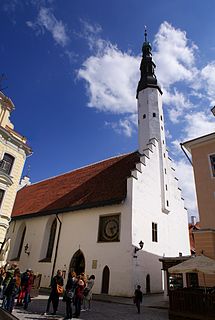 W
WThe Church of the Holy Ghost or Church of the Holy Spirit is a medieval Lutheran church in the old town district of Tallinn, Estonia. It is located behind Raekoja plats, and lies opposite the Great Guild and Maiasmokk, Tallinn's oldest café.
 W
WJuhkentali is a subdistrict in the district of Kesklinn (Midtown), Tallinn, the capital of Estonia. It has a population of 1,221.
 W
WKadriorg is a subdistrict in the district of Kesklinn (Midtown), Tallinn, the capital of Estonia. It has a population of 4,561. The subdistrict name derives from the Catherinethal, a Baroque palace of Catherine I of Russia. It is one of the wealthiest regions in Estonia.
 W
WKadriorg Palace is a Petrine Baroque palace built for Catherine I of Russia by Peter the Great in Tallinn, Estonia. Both the Estonian and the German name for the palace means "Catherine's valley". It was built after the Great Northern War for Nicola Michetti's designs by Gaetano Chiaveri and Mikhail Zemtsov. The palace currently houses the Kadriorg Art Museum, a branch of the Art Museum of Estonia, displaying foreign art from the 16th to 20th centuries. The KUMU branch of the museum, showing Estonian art from the 18th century onwards is located nearby in the park.
 W
WThe Kadriorg Stadium is a multi-purpose stadium in Tallinn, Estonia. It is currently used mostly for football matches and is the home stadium of Tallinna JK Legion and JK Tallinna Kalev. The stadium holds 5,000 and was built in 1926. The Kadriorg Stadium is located about 2 km east of the city centre in the subdistrict of Kadriorg near the Kadriorg Palace. The address of the stadium is Roheline aas 24, 10150 Tallinn.
 W
WKalevi Keskstaadion is a multi-purpose stadium in Tallinn, Estonia. It is currently used mostly for football matches and is the home stadium of Kalev Tallinn. The stadium holds 12,000 and was built in 1955. The address of the stadium is Staadioni 8, 10132 Tallinn.
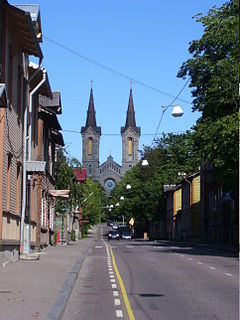 W
WKassisaba is a subdistrict in the district of Kesklinn (Midtown), Tallinn, the capital of Estonia. It has a population of 4,265.
 W
WKeldrimäe is a subdistrict in the district of Kesklinn (Midtown), Tallinn, the capital of Estonia. It has a population of 4,747.
 W
WKiek in de Kök is an artillery tower in Tallinn, Estonia, built in 1475. It gained the name Kiek in de Kök from the ability of tower occupants to see into kitchens of nearby houses. The tower is 38 m high and has walls 4 m thick. Cannon balls dating back to 1577 are still embedded in its outer walls.
 W
WKitseküla is a subdistrict of the district of Kesklinn (Midtown) in Tallinn, the capital of Estonia. It has a population of 4,053.
 W
WKompassi is a subdistrict in the district of Kesklinn (Midtown), Tallinn, the capital of Estonia. It has a population of 2,066.
 W
WLuite is a subdistrict in the district of Kesklinn (Midtown), Tallinn, the capital of Estonia. It has a population of 813.
 W
WMaakri is a subdistrict in the district of Kesklinn (Midtown), Tallinn, the capital of Estonia. It has a population of 979. In the last decade Maakri has developed into the main business centre of Tallinn. Many high-rise buildings have been built into the area during this period.
 W
WThe Mikkel Museum is a branch of the Art Museum of Estonia, located in Kadriorg park in Tallinn. It displays a collection of mainly Western art and ceramics, and Chinese porcelain, donated by art collector Johannes Mikkel in 1994.
 W
WMõigu is a subdistrict of the district of Kesklinn in Tallinn, the capital of Estonia. It is located on the northeastern side of Lake Ülemiste. It has a population of 377. Mõigu's former German name until 1918 was Moik, also spelled Moick.
 W
WThe Memorial to the Revolution of 1905 in Tallinn, Estonia, is a public monument erected to commemorate the events of the Revolution of 1905. The only writing upon the monument is the date of "1905", in a similar manner to its counterpart in Riga, Latvia.
 W
WThe New World is a 2011 Estonian documentary film about New World Society, a citizens' initiative in Uus Maailm, Tallinn, that aims to remake neighbourhoods and change people's lives. Written and directed by Jaan Tootsen, it was presented with the award for Best Film by the Estonian Association of Film Journalists.
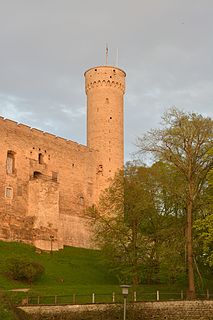 W
WPikk Hermann or Tall Hermann is a tower of the Toompea Castle, on Toompea hill in Tallinn, the capital of Estonia. The first part was built 1360–70. It was rebuilt in the 16th century. A staircase with 215 steps leads to the top of the tower. The tower consists of ten internal floors and a viewing platform at the top.
 W
WThe Raeapteek is a pharmacy in the center of Tallinn, Estonia.
 W
WRaekoja plats is a town square beside Tallinn Town Hall in the center of the Tallinn Old Town in Tallinn, Estonia. It is a venue for numerous small festivals or concerts like Tallinn Old Town Days, and several bars and restaurants are located in the near vicinity. The square also hosts a market regularly, with many stalls selling traditional Estonian items and souvenirs.
 W
WRaua is a subdistrict in the district of Kesklinn (Midtown), Tallinn, the capital of Estonia. It has a population of 5,654.
 W
WThe Russalka Memorial is a bronze monument sculpted by Amandus Adamson, erected on 7 September 1902 in Kadriorg, Tallinn, to mark the ninth anniversary of the sinking of the Russian warship Rusalka, or "Mermaid", which sank en route to Finland in 1893. It was the first monument in Estonia made by an Estonian sculptor. The monument depicts an angel holding an Orthodox cross towards the assumed direction of the shipwreck. The model for the angel was the sculptor's housekeeper Juliana Rootsi, whose grandson is the politician, Tiit Made.
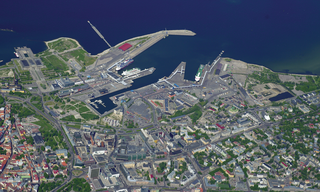 W
WSadama is a subdistrict in the district of Kesklinn (Midtown), Tallinn, the capital of Estonia. It has a population of 2,951.
 W
WSt. Nicholas Church is a medieval former church in Tallinn, Estonia. It was dedicated to Saint Nicholas, the patron of the fishermen and sailors. Originally built in the 13th century, it was partially destroyed in the Soviet bombing of Tallinn in World War II. It has since been restored and today houses the Niguliste Museum, a branch of the Art Museum of Estonia, focusing mainly on ecclesiastical art from the Middle Ages onward. The former church is also used as a concert hall.
 W
WSt. Olaf’s Church or St. Olav's Church in Tallinn, Estonia, is believed to have been built in the 12th century and to have been the centre for old Tallinn's Scandinavian community before Denmark conquered Tallinn in 1219. Its dedication relates to King Olaf II of Norway. The first known written records referring to the church date back to 1267. It was extensively rebuilt during the 14th century.
 W
WSfäär is a restaurant and store located at Mere puiestee 6E, in Tallinn, Estonia. It is noted for its Nordic cuisine and New Estonian cuisine with Italian influence, using fresh ingredients. The restaurant is described as "kind of a cross between an old Soviet-era cafeteria and a stylishly retro second living room." The restaurant is also a wine store and clothes store which sells designer jeans and other goods. One review said of the restaurant: "Italian and Nordic aren't exactly terms that get along well. Yet by some stroke of insane genius, Sfäär has found a way to force these to into a fusion. The result is a truly modern cuisine, presented in a contemporary and sleek setting with some tastefully incorporated retro elements."
 W
WSibulaküla is a subdistrict in the district of Kesklinn (Midtown), Tallinn, the capital of Estonia. It has a population of 2,120.
 W
WThe Original Sokos Hotel Viru Tallinn is a hotel in Tallinn, Estonia. Originally owned by Intourist and called Viru hotell, it was first opened on 5 May 1972. The hotel building was the first high-rise building in Estonia and an inseparable part of the Tallinn cityscape. Nowadays the hotel is connected to the shopping centre Viru Keskus. Nowadays, the hotel belongs to Sokos Hotels.
 W
WStenbock House is a prominent neo-classical building located on Toompea hill, Tallinn. It is the official seat of the Government of Estonia.
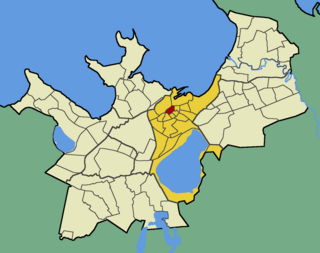 W
WSüdalinn is a subdistrict in the district of Kesklinn (Midtown), Tallinn, the capital of Estonia. It has a population of 169.
 W
WThe Tallinn bus station is the main long-distance bus station of Tallinn, Estonia. The bus station is located in the southeastern part of the city centre, in Juhkentali neighbourhood. The bus station is managed by Mootor Grupp AS. The address is Lastekodu tänav 46.
 W
WTallinn Christmas Market is a Christmas market held every year in Tallinn, Estonia. The modern Christmas market was founded in 1997 and it is open from the last week of November to the first week of January the following year. Founded by Paul Oberschneider, the market brings tourists from all over the world to Tallinn. This is due to the Julian calendar according to which, the Christmas Day of the Russian Orthodox Church is on 7 January.
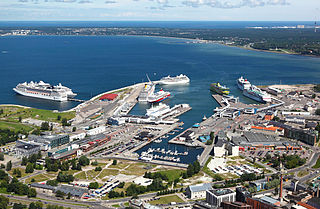 W
WThe Tallinn Passenger Port or the Old City Harbour is the main passenger harbour in Tallinn, Estonia. Regular lines serve routes to Helsinki (Finland), Stockholm (Sweden) and St. Petersburg (Russia).
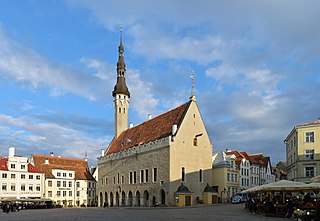 W
WThe Tallinn Town Hall is a building in the Tallinn Old Town, Estonia, next to the Town Hall Square. It is the oldest town hall in the whole of the Baltic region and Scandinavia.
 W
WTallinn University Academic Library is one of the most comprehensive research libraries of Estonia in all fields of knowledge, except construction and agriculture. It is located in Tallinn, the capital city of Estonia.
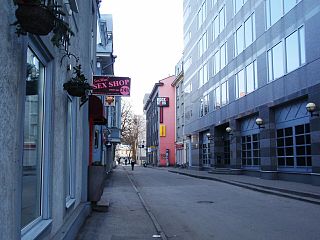 W
WTatari is a subdistrict in the district of Kesklinn (Midtown), Tallinn, the capital of Estonia. It has a population of 2,098.
 W
WTõnismägi is a 36-metre high hillock adjacent to Toompea hill in Tallinn, Estonia. From 1945 to 1996 the central portion of the hillock was called Liberators' Square. The place became internationally known in 2007 when the Estonian government relocated a Soviet war memorial known as the Bronze Soldier. Tõnismäe is also a subdistrict in the district of Kesklinn with a population of 1,404.
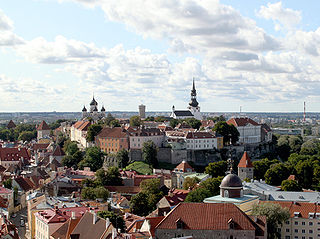 W
WToompea is a limestone hill in the central part of the city of Tallinn, the capital of Estonia. The hill is an oblong tableland, which measures about 400 by 250 metres, has an area of 7 hectares and is about 20–30 metres higher than the surrounding areas. In folklore the hill is known as the tumulus mound over the grave of Kalev, erected in his memory by his grieving wife.
 W
WToompea Castle is a castle on Toompea hill in the central part of Tallinn, the capital of Estonia. The castle, an ancient stronghold site in use since at least the 9th century, today houses the Parliament of Estonia.
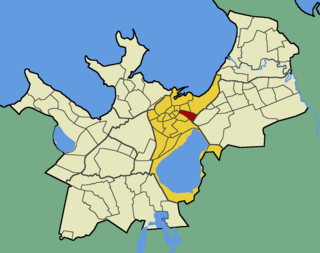 W
WTorupilli is a subdistrict in the district of Kesklinn (Midtown), Tallinn, the capital of Estonia. It has a population of 3,729.
 W
WUus Maailm is a subdistrict in the district of Kesklinn (Midtown), Tallinn, the capital of Estonia. It has a population of 7,442.
 W
WVanalinn is a subdistrict in the district of Kesklinn (Midtown), Tallinn, the capital of Estonia. It has a population of 4,437.
 W
WVeerenni is a subdistrict in the district of Kesklinn (Midtown), Tallinn, the capital of Estonia. It has a population of 3,769.
 W
WThe Cross of Liberty and the Monument to the War of Independence is located in Freedom Square, Tallinn, Estonia. It was opened on 23 June 2009 as a memorial for those who fell during the Estonian War of Independence, through which the people of Estonia will be able to commemorate all those who had fought for freedom and independence. The pillar is 23.5 m high and consists of 143 glass plates. The memorial incorporates the Cross of Liberty, Estonia's most distinguished award established in 1919.